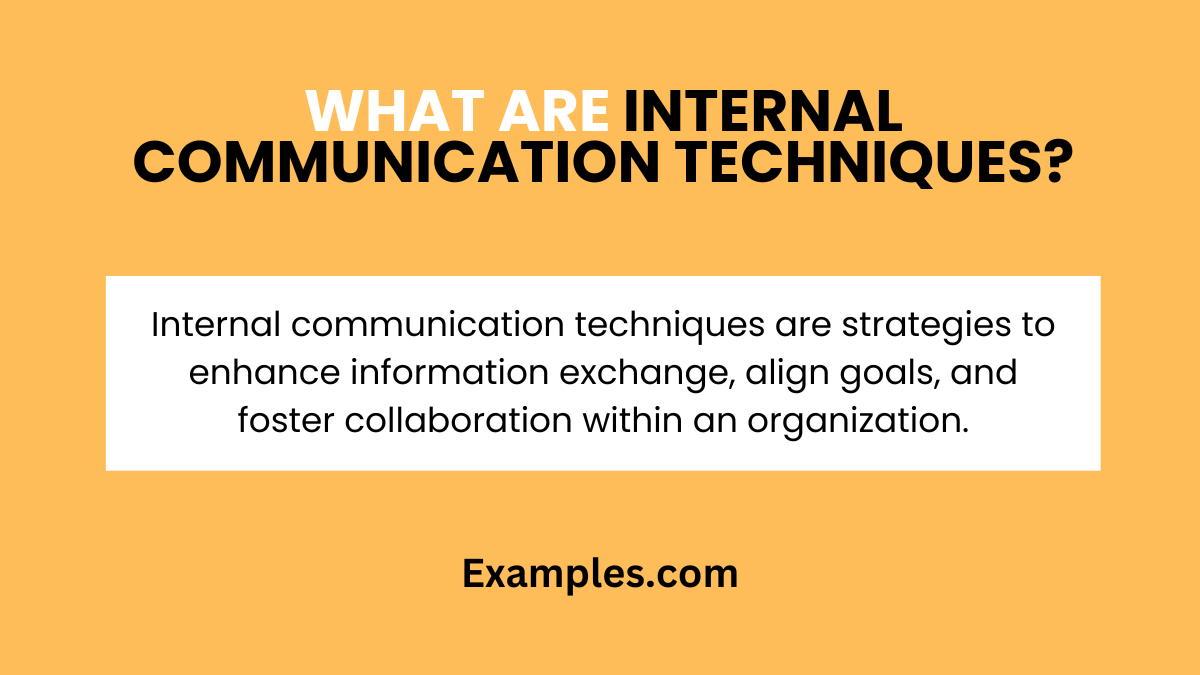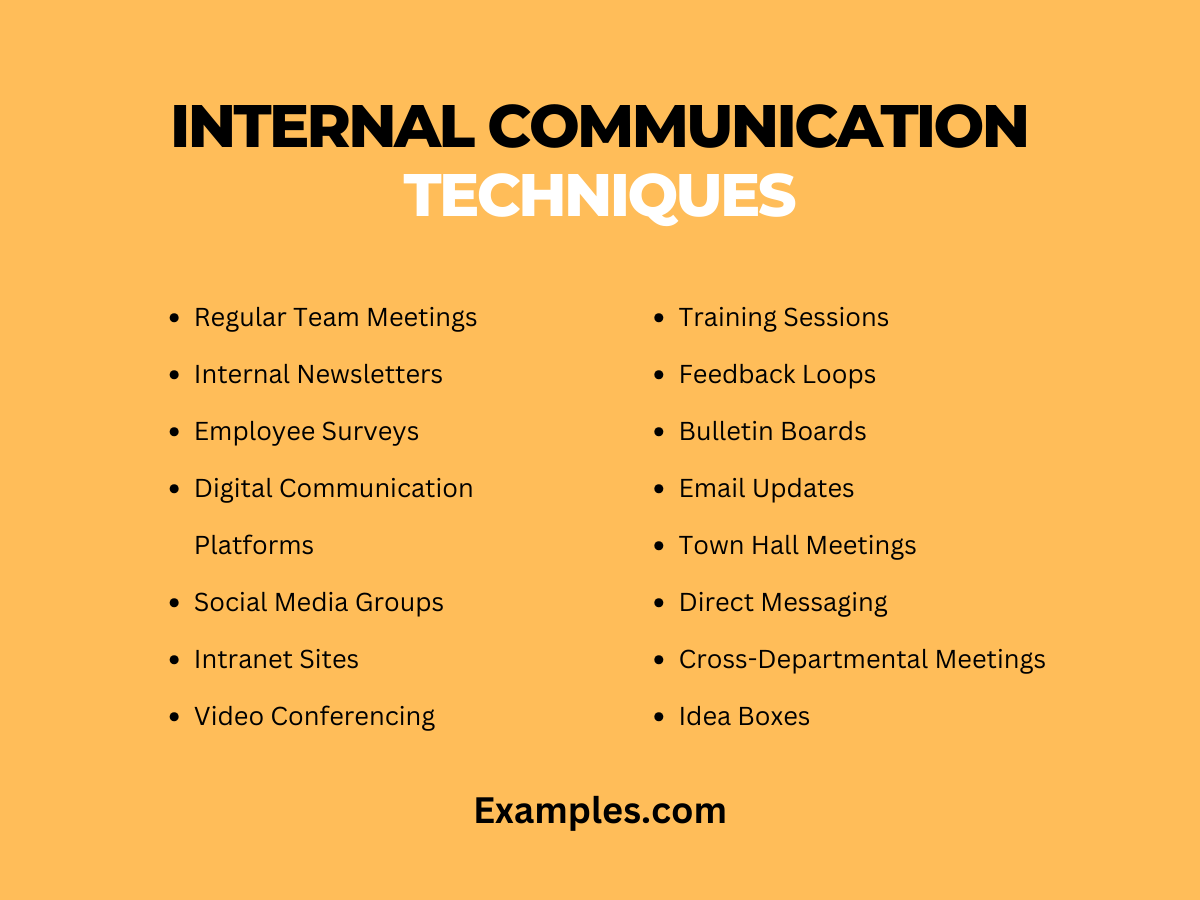14+ Internal Communication Techniques Examples
In this era of fast-paced corporate environments, mastering Internal Communication Techniques is key to organizational success. Our guide offers a deep dive into various methods and practices, backed by practical examples, to elevate your internal communication strategies. From fostering effective team dialogues to leveraging advanced communication technologies, we cover a spectrum of techniques that cater to diverse workplace settings. Whether you’re looking to refine existing communication methods or implement new ones, this guide is an invaluable resource for anyone aiming to enhance team dynamics and boost overall productivity. Immerse yourself in our detailed exploration of internal communication techniques and embark on a journey towards a more connected and efficient organizational communication system.
What are Internal Communication Techniques?

Internal communication techniques are methods and strategies used within an organization to facilitate clear, effective, and efficient exchange of information among employees. These techniques aim to ensure that all team members are aligned with the company’s goals, informed about important updates, and engaged in a collaborative, inclusive workplace culture. They can range from digital communication tools to regular team meetings and are essential for maintaining a connected, informed, and productive work environment.
15 Internal Communication Techniques

Effective internal communication is crucial for any organization’s success. This comprehensive guide explores 15 unique and impactful techniques, each accompanied by practical examples and how-to-use sentences. These methods range from traditional face-to-face interactions to innovative digital platforms, ensuring a well-rounded approach to enhancing workplace communication. By integrating these techniques, companies can foster a more engaged, informed, and cohesive team environment.
- Regular Team Meetings: Facilitate open discussions and updates about ongoing projects.
- Example: “In our weekly team meetings, let’s share progress and brainstorm solutions collaboratively.”
- Internal Newsletters: Keep employees updated on company news and achievements.
- Example: “Our monthly newsletter will highlight team successes and key company updates.”
- Employee Surveys: Collect feedback and suggestions from team members.
- Example: “Your input is valuable! Please complete this survey to help us improve our workplace.”
- Digital Communication Platforms: Utilize tools like Slack or Microsoft Teams for instant messaging and information sharing.
- Example: “Let’s continue this discussion on our Slack channel to include all team members.”
- Social Media Groups: Create private groups for informal interactions and bonding.
- Example: “Join our Facebook workgroup for the latest team updates and fun activities.”
- Intranet Sites: Centralize important documents and information for easy access.
- Example: “You can find all our project resources and guidelines on the intranet site.”
- Video Conferencing: Connect remote teams through platforms like Zoom or Skype.
- Example: “Let’s schedule a Zoom call to discuss the project timeline with our remote colleagues.”
- Feedback Loops: Encourage open and continuous feedback to improve processes.
- Example: “I welcome your feedback on my presentation today for future improvements.”
- Training Sessions: Conduct regular training for skill enhancement and team building.
- Example: “Join next week’s training session to improve your project management skills.”
- Bulletin Boards: Display important announcements and updates in common areas.
- Example: “Check the bulletin board for the latest safety protocols and guidelines.”
- Email Updates: Send concise and regular updates via email.
- Example: “Please read the attached email for important updates on our health insurance policy.”
- Town Hall Meetings: Organize company-wide meetings for major announcements.
- Example: “Our next town hall will address the new strategic directions of our company.”
- Direct Messaging: Encourage direct communication between employees and management.
- Example: “Feel free to send me a direct message if you have any immediate concerns.”
- Cross-Departmental Meetings: Facilitate meetings between different departments for better collaboration.
- Example: “This cross-departmental meeting will help align our marketing and sales strategies.”
- Idea Boxes: Place physical or digital suggestion boxes for anonymous feedback.
- Example: “Drop your innovative ideas in the idea box; we value your creativity and suggestions.”
Internal Communication Techniques in the Workplace
Effective internal communication techniques in the workplace are essential for fostering a collaborative and productive environment. Here’s how to implement them:
- Open Door Policy: Encourage an atmosphere where employees feel comfortable voicing their opinions and concerns. This policy not only promotes open communication but also helps in identifying and addressing issues promptly.
- Regular Team Huddles: Short, daily meetings can keep everyone aligned and informed. These huddles are a platform for quick updates, ensuring effective communication and reducing the chances of miscommunication.
- Utilize Collaboration Tools: Implement tools like Trello, Slack, or Asana to enhance team coordination. These digital platforms streamline communication, keeping everyone on the same page and fostering synchronous communication.
- Feedback Culture: Establish a system where feedback is regularly sought and given. This could be through performance reviews or informal check-ins, enhancing communication skills and internal communication.
- Visual Communication Aids: Use infographics, charts, and videos for complex data. Visual aids can simplify complicated information, making it easier to understand and retain.
Internal Communication Techniques for an Organization
For broader organizational impact, internal communication techniques need to be strategically implemented:
- Company-wide Newsletters: Regular newsletters can effectively disseminate important information to the entire staff, keeping everyone updated on company news and achievements, thus enhancing internal communication.
- Intranet Portals: An intranet portal serves as a central hub for all organizational information. It’s a one-stop-shop for news, updates, policies, and resources, streamlining internal communication and promoting effective communication.
- Leadership Communication: Regular updates from leadership about the company’s direction and strategy can build trust and transparency. This top-down communication is crucial in aligning the entire organization.
- Cross-Functional Workshops: These workshops encourage inter-departmental collaboration and understanding. They break down silos and foster a sense of unity, crucial for internal communication.
- Employee Recognition Programs: Recognizing and celebrating achievements boosts morale and encourages open sharing of successes, thereby enhancing internal communication.
Which Technique is Used for Internal Communication?
Selecting the right technique for internal communication depends on the organization’s size, culture, and objectives. Here are some commonly used techniques:
- Town Hall Meetings: Ideal for large organizations to communicate key messages from the top management and foster a sense of community.
- Direct Messaging and Emails: For quick, one-on-one communication, these tools are effective. They are suitable for providing specific instructions or feedback, enhancing internal communication.
- Social Media and Internal Blogs: These platforms are great for creating an engaging and interactive environment. They allow for sharing ideas and updates in a more relaxed setting.
- Employee Surveys and Suggestion Boxes: These tools are effective in gathering anonymous feedback and ideas from employees, contributing to a more democratic form of internal communication.
- Training and Development Programs: These not only enhance skills but also serve as a platform for communication and networking among employees, thus contributing to overall internal communication effectiveness.
In conclusion, our exploration of Internal Communication Techniques reveals a multitude of strategies to enhance workplace communication. From adopting digital tools to fostering a culture of openness, these techniques serve as a blueprint for effective organizational dialogue. Implementing these methods can lead to a more informed, cohesive, and productive workforce, ultimately driving success and fostering a positive work environment.



